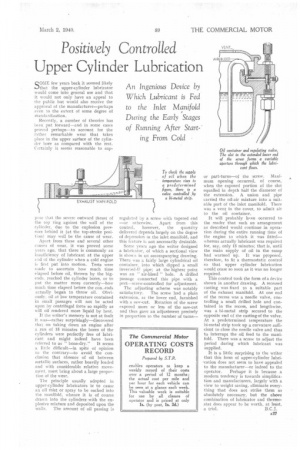Positively Controlled Upper Cylinder Lubrication
Page 37

If you've noticed an error in this article please click here to report it so we can fix it.
An Ingenious Device by Which Lubricant is Fed to the Inlet Manifold During the Early Stages of Running After Start ing From Cold SOME few years back it seemed likely that the upper-cylinder lubricator would come into general use and that it would not only have an appeal to the public but would also receive the approval of the manufacturer—perhaps even to the extent of some degree of standardization.
Recently, a number of theories has been put forward—and in some cases proved perhaps—to account for the rather remarkable wear. that takes place in the upper surface of the cylinder bore as compared with the rest. Certainly it seems reasonable to sup
pose that the severe outward thrust of the top ring against the wall of the cylinder, due to the explosion pressure behind it (at the top-stroke position) may well be the cause of wear.
Apart from these and several other causes of wear, it was proved some years ago, that there is commonly an insufficiency of lubricant at the upper end of the cylinder when a cold engine is first put into motion. Tests were made to ascertain how much time elapsed before oil, thrown by the bigends, reached the cylinder bores, or to put the matter more correctly—how much time elapsed before the con.-rods actually began to throw oil. Obviously, oil at low temperature contained in small passages will not be acted upon by centrifugal force so rapidly as will oil rendered more liquid by heat.
If the writer's memory is not at fault it was—rather surprisingly—discovered that on taking down an engine after a run of 15 minutes the bores of the cylinders were perfectly free of lubricant and might indeed have been referred to as " bone-dry." It seems a little difficult—in spite of opinion to the contrary—to avoid the conclusion that absence of oil between metallic surfaces, rather heavily loaded and with considerable relative movement, must bring about a large proportion of the wear.
The principle usually adopted in upper-cylinder lubricators is to cause an oil mist or spray to be sucked into the manifold, whence it is of course drawn into the cylinders with the explosive mixture and deposited upon the walls. The amount of oil passing is
regulated by a screw with tapered end —or otherwise. Apart from this control, however, the quantity delivered depends largely on the degree of depression in the inlet manifold, and this feature is not necessarily desirable.
Some years ago the writer designed a lubricator, of which a sectional view is shown in an accompanying drawing. There was a fairly large cylindrical oil container, into which dipped a small inverted-11 pipe; at the highest point was an " air-bleed " hole. A drilled passage connected this pipe with a port—screw-controlled for adjustment.
The adjusting scheme was notably
satisfactory. The screw had a plain extension, at the lower end, furnished with a saw-cut. Rotation of the screw exposed more or less of the saw-cut and thus gave an adjustment precisely in proportion to the number of turns—
or part-turns—of the screw. Maximum opening occurred, of course, when the exposed portion of the slot equalled in depth half the diameter of the extension. A union and pipe carried the oil-air mixture into a suitable part of the inlet manifold. There was a vent in the cover, to admit air to the oil container.
It will probably 'nye occurred to the reader that such an arrangement as described would continue in operation during the entire running time of the engine to which it was fitted— whereas actually lubricant was required for, say, only 15 minutes; that is, until the main supply of oil in the sump had warmed up. It was proposed, therefore, to fit a thermostatic control so that upper cylinder lubrication would cease so soon as it was no longer required.
This control took the form of a device shown in another drawing. A recessed casting was fixed to a suitable part of the exhaust manifold. At one end of the recess was a needle valve, controlling a small drilled hole and contained in the recess, and lengthwise, was a hi-metal strip secured to the opposite end of the casting of the valve. At a predetermined temperature the hi-metal strip took up a curvature sufficient to close the needle valve and thus to interrupt the oil feed to the manifold. There was a screw to adjust the period during which lubricant was supplied.
It is a little surprising to the writer that this form of upper-cylinder lubri-cation does not seem to have appealed to the manufacturer—or indeed to the operator. Perhaps it is because a modern tendency is towards simplificatLon and manufacturers, largely with a view to weight saving, eliminate everything that does not strike them as absolutely necessary, but the above combination of lubricator and themostat does appear to be worth, at least, a trial. B.C. T.




































































